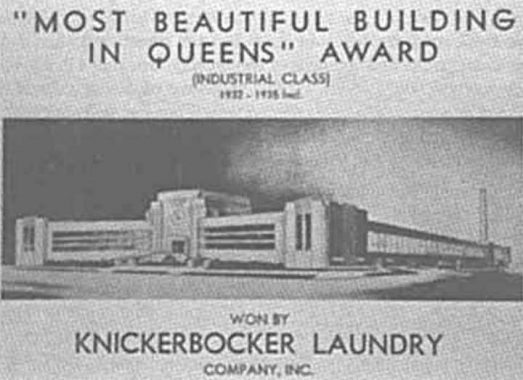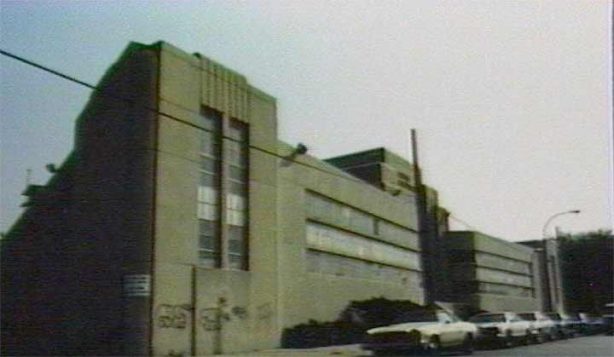
ONLY in the ‘dirty 30s’ (as weatherman Tex Antoine used to say) could a laundry be named the most beautiful building in Queens…though in the borough of Archie Bunker, maybe that isn’t such an anomaly after all.
I have been riding the Long Island Railroad from Queens to Manhattan since 1992 and on each trip on the north side of the tracks, you could always see the Knickerbocker Laundry. The 1936 building was an exaggerated streamline design, a side category of Art Deco called Streamline Moderne. (Other examples are the Triborough Bridge approaches and the set design of 1936 H.G. Wells adaptation, Things To Come.)

Curvilinear lines, perfectly symmetrical design, and a huge clock above the front entrance earned the “Beautiful Building” accolade from the Queens Chamber of Commerce soon after its opening. It was quite modernistic for its time and its design would be echoed in the futuristic buildings featured in the 1939-40 World’s Fair in Flushing Meadows.
An expansion of the Knickerbocker Ice business, which was seeking to expand into other ways to make money, the Knickerbocker Laundry was constructed in 1931 with a design by architect Irving Fenichel.
Inside were huge washing, pressing, ironing, steam, dry-cleaning and other machines, and a separate boiler room. Huge windows and tiled surfaces made the interior appear as clean as a hospital. Everything from fragile linens to great rugs were cleaned in a carefully air-conditioned, dust-free atmosphere, but the most striking quality of the Knickerbocker Laundry building was its near-public character. {Christopher Gray, New York Times]

The Knickerbocker Laundry, and later, Naarden Fragrances, occupied the structure until 1986 when it began a slow slide into utter oblivion and disrepair, which is how I encountered it in 1992. But just a couple of years later, there was a renaissance as the New York Presbyterian Church, with a primarily Korean congregation, purchased the building, and as you can see, renovated it from stem to stern. Very few of its original Streamline Moderne Le Corbusier-ish touches remain.
As always, “comment…as you see fit.” I earn a small payment when you click on any ad on the site.
6/21/23


5 comments
Great posting. I have passed the same location on the LIRR literally thousands of times, and never knew the history of the old Knickerbocker Laundry building.
Knickerbocker Ice had an interesting history. It originated in the 19th to fill the demand for ice in New York City as a means to preserve food in warm weather. Ice was harvested from fresh water bodies in the Hudson Valley, notably in Rockland County, and then barged to New York City for use. A whole network of water craft and insulated ice houses were established to transport and store the ice.
Electricity and mechanical refrigeration killed the ice industry, and the Knickerbocker company stopped harvesting ice in 1924, so it made sense to venture into other businesses. In 1946, an abandoned Knickerbocker icehouse in Washington Heights, Manhattan burned on December 13, 1946, collapsed, and destroyed the adjacent apartment building on Amsterdam Avenue, killing 37 people.
Link to Wikipedia article about Knickerbocker, which includes a link to a NY Times article about a person who survived the 1946 catastrophe: https://en.wikipedia.org/wiki/Knickerbocker_Ice_Company
Shame on you for your dismissive comment regarding Queens architecture. Review your very own archive & you’ll see many examples of elegant Queens architecture. Examples can be found in Jamaica Estates & on Parsons Blvd. at the T-head intersection where Kissena Park interrupts it. In the northbound lane is a Tudor-style house worth a second look. I recall seeing an article in the Sunday NY Times real estate section fifty years ago featuring this gem. When I lived on Roosevelt Avenue I would deliberately use Parsons Blvd, as my route to Fresh Meadows just so that I could pass by this great looking neighborhood.
There is a great picture of all the laundry help, drivers, etc lined up in front in full uniforms – a classic of mid-century workforce.
For many years, commuters on the LIRR passed by this church,
and it had the quote from Lamentations 1:12 on it:
“Is it nothing to you, All ye that pass by?”
I wish they could restore this quote to the building.
Creation of a the new Sunnyside Yards, in Queens, offered a blank slate on which industrial development could happen in a modern manner. The Knickerbocker Laundry was late entry in that effort. One of the pioneers was the Sunshine Biscuit Building in 1912. Nicknamed the “Thousand Window” bakery, it was the largest bakery building in the world and maintained that claim until the 1950’s. The clean, airy, plant was a far cry from the typically small, dark, and cramped bakeries of the day. Another modern bakery, Silvercup, was added to the Long Island City community in 1920. American Chicle’s factory (Chiclets and Dentyne) was also built in 1920, Automobile manufacturers, such as Ford, Pierce Arrow, and others, were also present, and built modern factories in Long Island City. Although most industry has left the area, these building still remain, having been converted to modern use. In their day, these were incredibly modern facilities and the buildings had ornamental elements that are still pleasing today. Many of them can be found in earlier Forgotten NY posts.